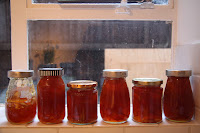Marmalade, like jam, is easy to make but you do need time to do it. Contrary to what most recipe books suggest, I have never got my marmalade (or any other jam) to setting point in 15 minutes. Questions of cooking time, setting point and other marmalade myths I have tried to deal with below. The result is, I hope, a recipe that will uplift your breakfast table and shake off any early morning blues.
Marmalade
(makes 5 - 8 jars depending on the size of your jars)1kg Seville oranges
3 lemons
2kg granulated sugar
Scrub the fruit and remove the buttons at the top. Put the fruit whole into a large saucepan or preserving pan with 2.5 litres of water. Bring to the boil and then simmer for 2 - 2.5 hours until the skins are tender and can be pierced easily with a fork.
Using a large spoon, remove the oranges and lemons and when they are cool enough to handle cut them into quarters. Remove the flesh and pith and pass through a sieve. You should be left with a sieve full of pith and pips and a bowl underneath the sieve full of a thick (and very bitter!) orange puree.
Put the pith and pips into a jelly/muslin bag (if you don't have one an old stocking will work just as well!) and tie a knot at the top. Cut up the peel into thick, medium or thin shreds depending on your preference.
Measure the cooking water - you should have about 1.7 litres. Make it up to this amount with water if you have less, discard some if you have too much.
Put the orange and lemon shreds, cooking water, sugar and bag of pith and pips into a large saucepan or preserving pan. (The pan needs to be big enough to bring the marmalade to a roaring boil and keep it there without boiling over - I would use the biggest one you have - you really need a couple of inches of space at the top of the pan - if necessary divide between two pans.)
Bring the marmalade to the boil, stirring until the sugar has completely dissolved. Bring it up to a roaring boil and let it boil ferociously until setting point is reached.
Setting point
 The easiest way to test whether your marmalade (or any jam) will set once cool is to put a small plate in the fridge and test the marmalade by dropping a little onto the cold plate. Allow it to cool for a minute and then push it gently with your finger. If the surface of the marmalade crinkles, it has reached setting point.
The easiest way to test whether your marmalade (or any jam) will set once cool is to put a small plate in the fridge and test the marmalade by dropping a little onto the cold plate. Allow it to cool for a minute and then push it gently with your finger. If the surface of the marmalade crinkles, it has reached setting point. Recipe books often underestimate the time it takes for marmalade (or jam) to reach setting point. They often optimistically suggest a boiling time of 10-15 minutes. This is one of the great kitchen myths (spread by people who presumably think it's amusing that you might start making marmalade at 9pm on a Sunday evening because that's all the time you've left yourself after a busy weekend and it's only going to take 15 minutes to cook...) I have never got any jam or marmalade to setting point in 15 minutes. Once your marmalade has reached a roaring boil, it is likely to take approximately 45 minutes to reach setting point (and longer if you've made a double quantity). Don't be tempted to give up before setting point is reached (in an entirely understandable fit of doubt that it's ever going to get there) as no-one wants orange syrup on their toast (despite what your guests may say as orange syrup dribbles menacingly down their hand towards their elbow...). Persevere, it just takes (a lot) longer than the books suggest.
Once setting point is reached, turn off the heat and let the marmalade cool for 10 minutes (this allows the fruit to settle so it will be distributed evenly between your jars). Then pour into warm, sterilised jars (the easiest way to do this is to heat the jars gently in a low oven) and seal immediately.
Other options: you can use almost any citrus fruits to make marmalade. The above is my basic recipe but try any variations and combinations of fruit. I have also made the above recipe this year with 2 pink grapefruit, 2 lemons and the remaining weight in oranges for a wonderfully tangy, refreshing marmalade.

Hi, I was surprised about your comments about setting: my marmalade sets just as it's coming to the boil and I'm stood there wondering whether I should at least try to keep it boiling for 10 minutes, or just pot it up. I use sliced fruit method, not boiling whole fruit method, and leave the sliced fruit to soak in the water overnight. Perhaps this helps?
ReplyDeleteThank you for the tip. I debate every year between the whole fruit and sliced fruit method! Did you make orange only or did you add other fruit?
ReplyDelete